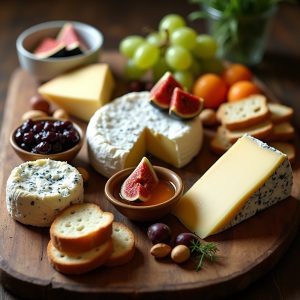
AI generated image
Chef's Tip
Remove cheeses from refrigeration at least one hour before serving. Fine cheeses should be enjoyed at room temperature for optimal flavor development and texture. Serve soft cheeses whole with appropriate knives, and pre-slice firm cheeses for easier enjoyment.
Instructions
- Remove all cheeses from refrigerator at least 1 hour before serving to reach room temperature.
- Prepare baguette: Slice into 1/4-inch rounds. Arrange on baking sheet and toast in a 350°F oven until lightly golden, about 5-7 minutes. Let cool.
- Wash and prepare fresh fruits: Quarter figs, separate grapes into small clusters.
- For presentation, select an appropriate serving board or platter. A wooden cheese board, marble slab, or slate plate works well.
- Arrange cheeses on the board, spacing them apart and considering visual balance.
- Place Brie or Camembert whole, with a small wedge cut out to invite guests to serve themselves.
- Cut Comté into thin slices or small wedges and arrange in a fan pattern.
- Place Roquefort as a wedge with a cheese knife nearby for easy serving.
- Form chèvre into a log or small rounds, depending on the variety.
- Arrange accompaniments in small groups around the cheeses: fig jam in a small dish with a serving spoon.
- Drizzle honey into a small dish with a honey dipper.
- Place fresh figs, grape clusters, dried apricots, and nuts in attractive groupings.
- Arrange toasted baguette slices and crackers in a separate basket or in small stacks on the board.
- Garnish with fresh herb sprigs for visual appeal and aroma.
- Provide appropriate cheese knives: a pointed knife for hard cheese, a spreading knife for soft cheese, etc.
Plating
Arrange the cheeses in a clock-like pattern on a round wooden board or slate, with space between each variety. Place small bowls of fig jam and honey near the center. Arrange fresh fruits, dried fruits, and nuts in small clusters between the cheeses. Position toasted baguette slices and crackers in a fan pattern along one edge of the board. Tuck small sprigs of fresh herbs between items for color and aroma. Provide appropriate cheese knives for each cheese type.
Storage & Reheating
Leftover cheeses should be wrapped individually in cheese paper or wax paper, then loosely in plastic wrap, and refrigerated. Consume soft cheeses within 3-5 days and harder cheeses within 1-2 weeks. Always bring cheeses back to room temperature before serving again. Store crackers and nuts in airtight containers at room temperature.
About This Recipe
The cheese course is a revered tradition in French gastronomy, often served either before dessert or as an alternative finale to a fine meal. This carefully curated selection represents the diverse styles of French cheese-making, from the creamy softness of Brie to the crystalline texture of aged Comté and the bold character of Roquefort. The thoughtful accompaniments enhance and complement the cheeses, allowing diners to create personalized flavor combinations.
